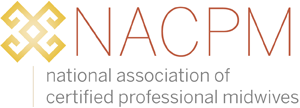Dear Members and Friends in the Midwifery Community,
We, on behalf of the NACPM leadership team, are writing to respond to misinformation that has recently been circulating in the CPM community, and to help address the resulting distress and concern among NACPM members and stakeholders.
The ACOG Toolkit, State Legislative ToolKit: Licensure and Regulation of Certified Professional Midwives (CPMs), currently being circulated and causing distress and doubt, was published in 2011 and is outdated. It does not reflect the ICM Global Standards on Regulation which support autonomous midwifery, the regulation of midwives by midwives, and full-scope midwifery practice in all jurisdictions. It does not reflect ACOG’s own statements over the past year, supporting fully-integrated care for all childbearing women, and the ICM Standards as the basis of education and regulation for midwives. It does not reflect the current progress that is being made by historic teamwork among maternity care stakeholders and providers. And it does not reflect the exciting and heartening progress for several CPM licensure bills and regulations that have been passed or that are finally moving forward in many states, including Maryland, Rhode Island and Delaware – after being stalled for many years by the very kind of opposition prescribed in the outdated 2011 ACOG Toolkit.
NACPM, along with our US MERA partners, is fully committed to vigorous support for the midwives model of care, to an autonomous, collaborative midwifery profession in the U.S., and to increasing – not limiting – access to high-quality education that meets international standards for all midwives. Our deep commitment to increasing affordability and access to education for all aspiring midwives is one of our principle reasons for partnering with US MERA.
NACPM is in the trenches for CPMs and families to do the hard work of resolving issues that have stood in the way of advancing midwifery and women’s access to midwives in the U.S. for far too long. We are committed to supporting the necessary conversations within the CPM community and shaping partnerships with previous adversaries – for the sake of women, babies, families, communities and the nation.
In support of these commitments, NACPM has been a leader in the historic US MERA collaboration, where midwives who have been at odds for decades now have a 4-year history of resolve and effectiveness that is unprecedented. NACPM has led in the development and convening of the Home Birth Summits for reaching common ground on our shared responsibility across the entire system for childbearing women in all birth settings. We are making great strides in a sturdy launch of NACPM chapters, giving midwives in states across the country the opportunity to engage in these critical conversations with national leadership and with each other to promote direct-entry midwifery as a cornerstone for childbearing women in the U.S.
NACPM and our US MERA partners are currently working hard to be able to share the results of our collaboration’s 2015 Annual Meeting this past April. The power of a coalition lies is in its ability to achieve consensus that all members of the coalition can fully support and stand behind. As many of you know from experience, consensus – and the power that comes with it – takes time to achieve. We recognize that this leaves an information gap at a time when our communities need to hear from us. Please watch soon for a US MERA report and other opportunities to learn and engage.
And please work with us to keep open the dialogue that supports and allows for change and evolution, even in places that have been stuck for decades. We are committed to creating a system of seamless, integrated, respectful, accountable care that will benefit all.
With great respect and faith,
Mary Lawlor, CPM
Executive Director, NACPM
Ellie Daniels, CPM
President, NACPM
National Association of Certified Professional Midwives
